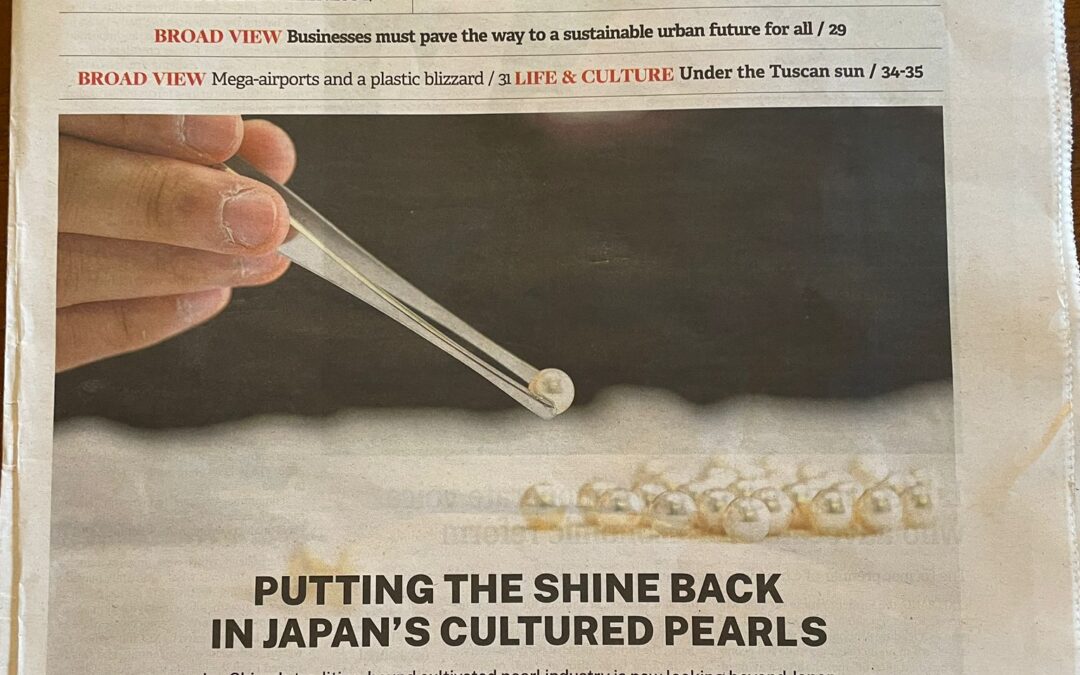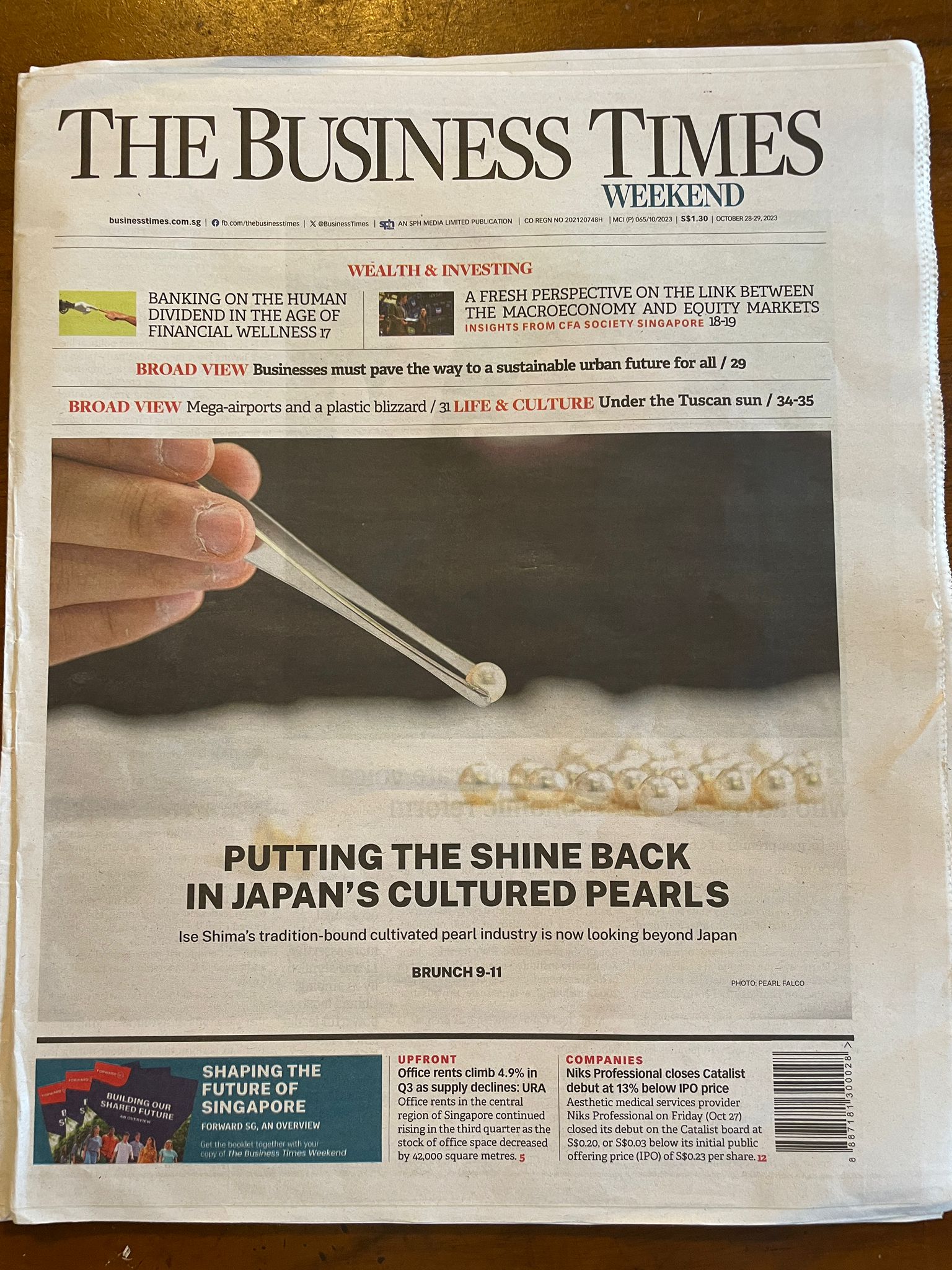
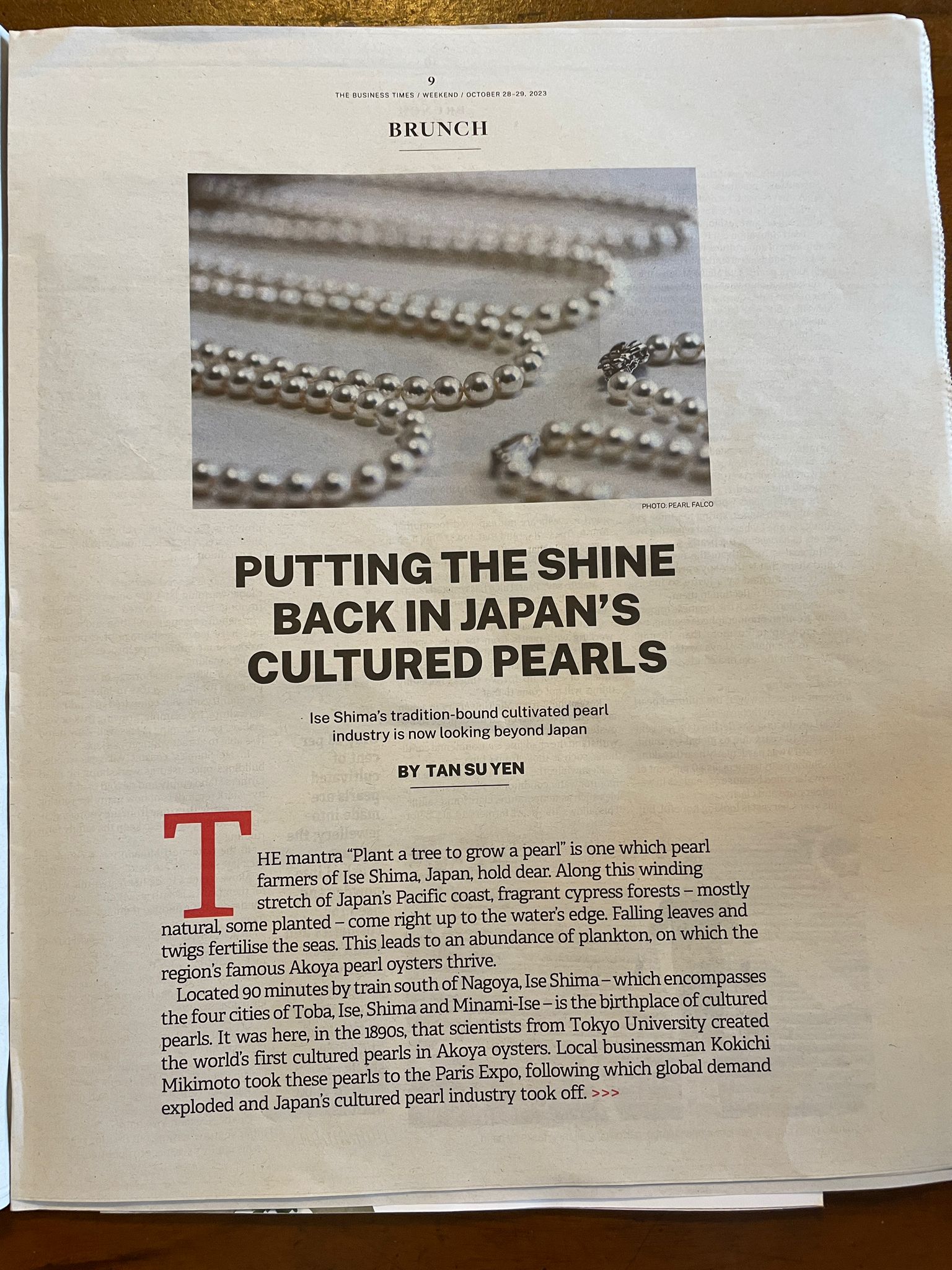
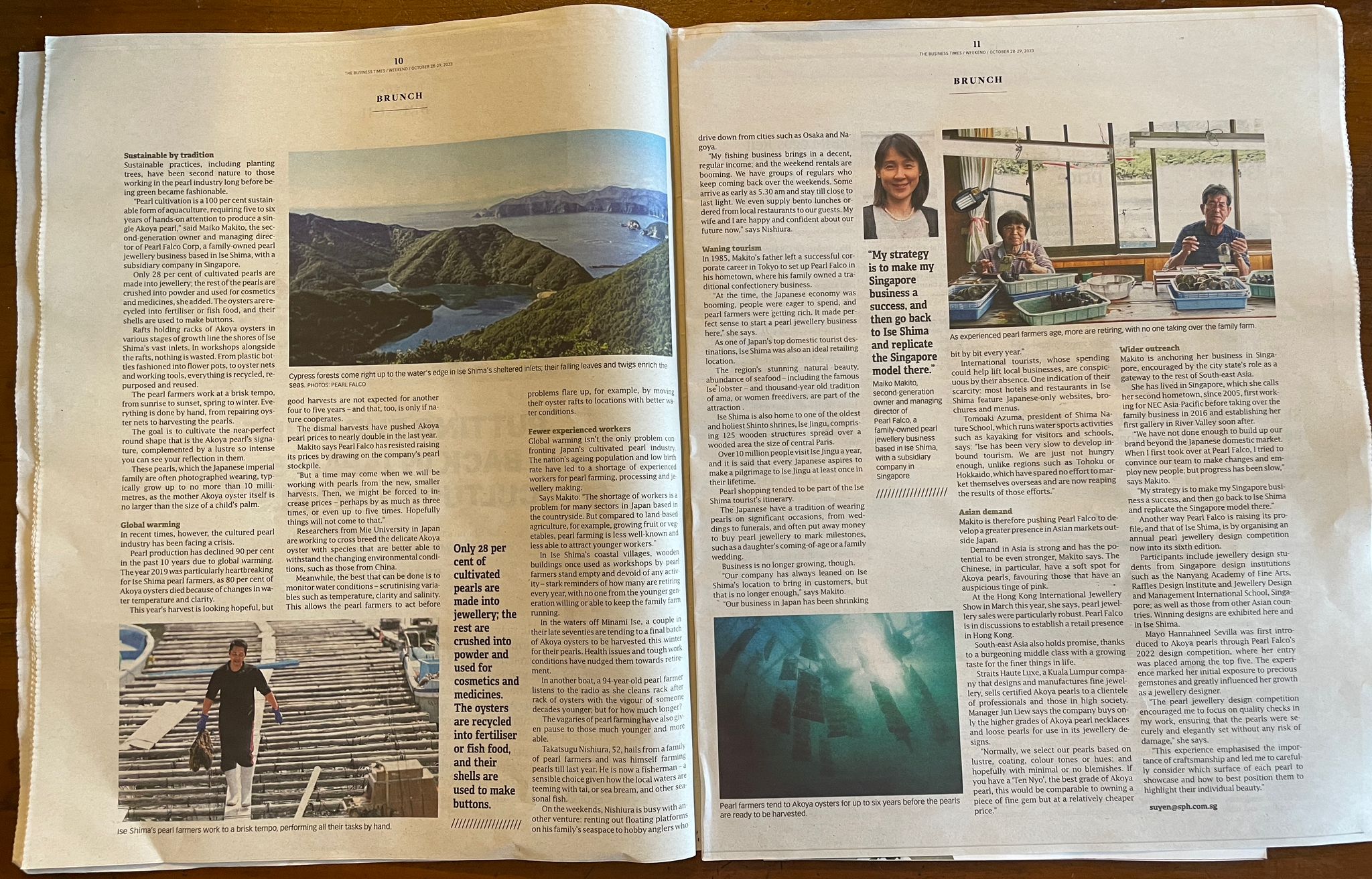
Pearl FALCO is honored to have been featured on The Business Times for again, this time on the first page of the 28th October 2023 issue, written by Tan Su Yen. Featuring the current challenges faced in the Akoya Pearl Farming industry, as well as sustainability and environmental issues that everyone should be aware of.
Bringing the lustre back to Japan’s cultured pearls
THE mantra “Plant a tree to grow a pearl” is one which pearl farmers of Ise Shima, Japan, hold dear.
Along this winding stretch of Japan’s Pacific coast, fragrant cypress forests – mostly natural, some planted – come right up to the water’s edge. Falling leaves and twigs fertilise the seas. This leads to an abundance of plankton, on which the region’s famous Akoya pearl oysters thrive.
Located 90 minutes by train south of Nagoya, Ise Shima – which encompasses the four cities of Toba, Ise, Shima and Minami-Ise – is the birthplace of cultured pearls.
It was here, in the 1890s, that scientists from Tokyo University created the world’s first cultured pearls in Akoya oysters. Local businessman Kokichi Mikimoto took these pearls to the Paris Expo, following which global demand exploded and Japan’s cultured pearl industry took off.
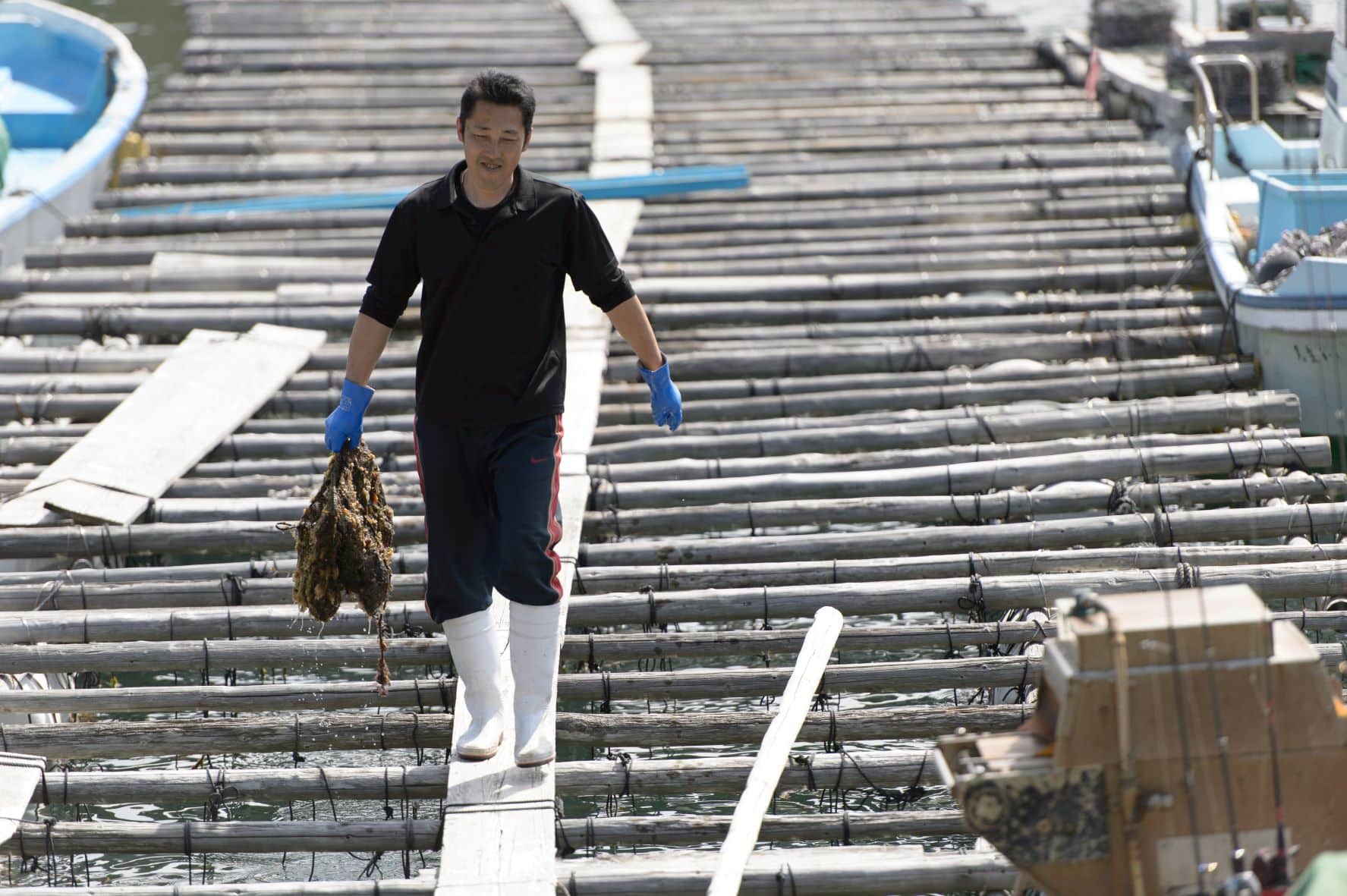
Sustainable by tradition
Sustainable practices, including planting trees, have been second nature to those working in the pearl industry long before being green became fashionable.
“Pearl Cultivation is a one hundred percent sustainable form of aquaculture, requiring five to six years of hands-on attention to produce a single Akoya Pearl.” said Maiko Makito, the second-generation owner and managing director of Pearl Falco Corp, a family-owned pearl jewellery business based in Ise Shima, with a subsidiary company in Singapore.
Only 28 per cent of cultivated pearls are made into jewellery; the rest of the pearls are crushed into powder and used for cosmetics and medicines, she added. The oysters are recycled into fertiliser or fish food, and their shells are used to make buttons.
Rafts holding racks of Akoya oysters in various stages of growth line the shores of Ise Shima’s vast inlets. In workshops alongside the rafts, nothing is wasted. From plastic bottles fashioned into flower pots, to oyster nets and working tools, everything is recycled, repurposed and reused.
The pearl farmers work at a brisk tempo, from sunrise to sunset, spring to winter. Everything is done by hand, from repairing oyster nets to harvesting the pearls.
The goal is to cultivate the near-perfect round shape that is the Akoya pearl’s signature, complemented by a lustre so intense you can see your reflection in them.
These pearls, which the Japanese imperial family are often photographed wearing, typically grow up to no more than 10 millimetres, as the mother Akoya oyster itself is no larger than the size of a child’s palm.
Global warming
In recent times, however, the cultured pearl industry has been facing a crisis.
Pearl production has declined 90 per cent in the past 10 years due to global warming. The year 2019 was particularly heartbreaking for Ise Shima pearl farmers, as 80 per cent of Akoya oysters died because of changes in water temperature and clarity.
This year’s harvest is looking hopeful, but good harvests are not expected for another four to five years–and that, too, is only if nature cooperates.
The dismal harvests have pushed Akoya pearl prices to nearly double in the last year. Makito says Pearl Falco has resisted raising its prices by drawing on the company’s pearl stockpile.
“But a time may come when we will be working with pearls from the new, smaller harvests. Then, we might be forced to increase prices–perhaps by as much as three times, or even up to five times. Hopefully things will not come to that.”
Researchers from Mie University in Japan are working to cross breed the delicate Akoya oyster with species that are better able to withstand the changing environmental conditions, such as those from China.
Meanwhile, the best that can be done is to monitor water conditions – scrutinising variables such as temperature, clarity and salinity. This allows the pearl farmers to act before problems flare up, for example, by moving their oyster rafts to locations with better water conditions.
Fewer experienced workers
Global warming isn’t the only problem confronting Japan’s cultivated pearl industry. The nation’s ageing population and low birth rate have led to a shortage of experienced workers for pearl farming, processing and jewellery making.
Says Makito: “The shortage of workers is a problem for many sectors in Japan based in the countryside. But compared to land-based agriculture, for example, growing fruit or vegetables, pearl farming is less well-known and less able to attract younger workers.”
In Ise Shima’s coastal villages, wooden buildings once used as workshops by pearl farmers stand empty and devoid of any activity–stark reminders of how many are retiring every year, with no one from the younger generation willing or able to keep the family farm running.
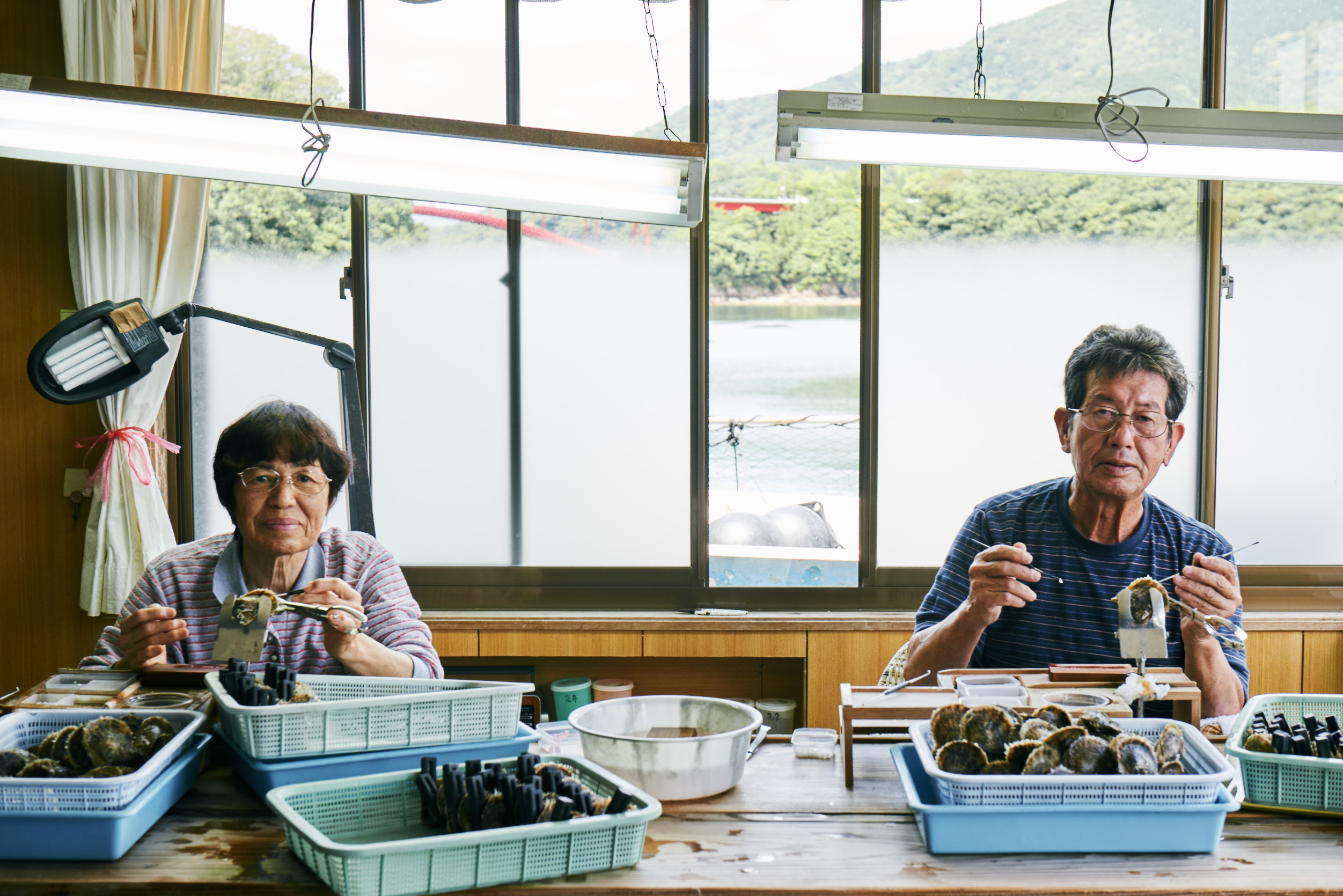
As experienced pearl farmers age, more are retiring, with no one taking over the family farm.
In the waters off Minami Ise, a couple in their late seventies are tending to a final batch of Akoya oysters to be harvested this winter for their pearls. Health issues and tough work conditions have nudged them towards retirement.
In another boat, a 94-year-old pearl farmer listens to the radio as she cleans rack after rack of oysters with the vigour of someone decades younger; but for how much longer?
The vagaries of pearl farming have also given pause to those much younger and more able.
Takatsugu Nishiura, 52, hails from a family of pearl farmers and was himself farming pearls till last year. He is now a fisherman – a sensible choice given how the local waters are teeming with tai, or sea bream, and other seasonal fish.
On the weekends, Nishiura is busy with another venture: renting out floating platforms on his family’s seaspace to hobby anglers who drive down from cities such as Osaka and Nagoya.
“My fishing business brings in a decent, regular income; and the weekend rentals are booming. We have groups of regulars who keep coming back over the weekends. Some arrive as early as 5.30 am and stay till close to last light. We even supply bento lunches ordered from local restaurants to our guests. My wife and I are happy and confident about our future now.” says Nishiura.
Waning tourism
In 1985, Makito’s father left a successful corporate career in Tokyo to set up Pearl Falco in his hometown, where his family owned a traditional confectionery business.
“At the time, the Japanese economy was booming, people were eager to spend, and pearl farmers were getting rich. It made perfect sense to start a pearl jewellery business here,” she says.
As one of Japan’s top domestic tourist destinations, Ise Shima was also an ideal retailing location.
The region’s stunning natural beauty, abundance of seafood–including the famous Ise lobster–and thousand-year old tradition of ama, or women freedivers, are part of the attraction.
Ise Shima is also home to one of the oldest and holiest Shinto shrines, Ise Jingu, comprising 125 wooden structures spread over a wooded area the size of central Paris.
Over 10 million people visit Ise Jingu a year, and it is said that every Japanese aspires to make a pilgrimage to Ise Jingu at least once in their lifetime.
Pearl shopping tended to be part of the Ise Shima tourist’s itinerary.
The Japanese have a tradition of wearing pearls on significant occasions, from weddings to funerals, and often put away money to buy pearl jewellery to mark milestones, such as a daughter’s coming-of-age or a family wedding.
Business is no longer growing, though.
“Our company has always leaned on Ise Shima’s location to bring in customers but that is no longer enough,” says Makito.
“Our Business in Japan has been shrinking bit by bit every year.”
International tourists, whose spending could help lift local businesses, are conspicuous by their absence. One indication of their scarcity: most hotels and restaurants in Ise Shima feature Japanese-only websites, brochures and menus.
Tomoaki Azuma, President of Shima Nature School, which runs water sports activities such as kayaking for visitors and schools, says: “Ise has been very slow to develop inbound tourism. We are just not hungry enough, unlike regions such as Tohoku or Hokkaido, which have spared no effort to market themselves overseas and are now reaping the results of those efforts.”
Asian demand
Makito is therefore pushing Pearl Falco to develop a greater presence in Asian markets outside Japan.
Demand in Asia is strong and has the potential to be even stronger, Makito says. The Chinese, in particular, have a soft spot for Akoya pearls, favouring those that have an auspicious tinge of pink.
At the Hong Kong International Jewellery Show in March this year, she says, pearl jewellery sales were particularly robust. Pearl Falco is in discussions to establish a retail presence in Hong Kong.
South-east Asia also holds promise, thanks to a burgeoning middle class with a growing taste for the finer things in life.
Straits Haute Luxe, a Kuala Lumpur company that designs and manufactures fine jewellery, sells certified Akoya pearls to a clientele of professionals and those in high society. Manager Jun Liew says the company buys only the higher grades of Akoya pearl necklaces and loose pearls for use in its jewellery designs.
“Normally, we select our pearls based on lustre, coating, colour tones or hues; and hopefully with minimal or no blemishes. If you have a ‘Ten Nyo’, the best grade of Akoya pearl, this would be comparable to owning a piece of fine gem but at a relatively cheaper price.”
Wider outreach
Makito is anchoring her business in Singapore, encouraged by the city state’s role as a gateway to the rest of South-east Asia.
She has lived in SIngapore, which she calls her second hometown, since 2005, first working for NEC Asia-Pacific before taking over the family business in 2016 and establishing her first gallery in Rivver Valley soon after.
“We have not done enough to build up our brand beyond the Japanese domestic market. When I first took over at Pearl Falco, I tried to convince our team to make changes and employ new people; but progress has been slow,” says Makito.
“My strategy is to make my Singapore business a success, and go back to Ise Shima and replicate the Singapore model there.”
Another way Pearl Falco is raising its profile, and that of Ise Shima, is by organising its annual pearl jewellery design competition now into its sixth edition.
Participants include jewellery design students from Singapore institutions – such as the Nanyang Academy of Fine Arts, Raffles Design Institute and Jewellery Design and Management International School, Singapore–as well as those from other Asian countries. Winning designs are exhibited here and in Ise Shima.
Mayo Hannahneel Sevilla was first introduced to Akoya pearls through Pearl Falco’s 2022 design competition, where her entry was placed among the top five. The experience marked her initial exposure to precious gemstones and greatly influenced her growth as a jewellery designer.
“The pearl jewellery design competition encouraged me to focus on quality checks in my work, ensuring that the pearls were securely and elegantly set without any risk of damage,” she says.
“This experience emphasised the importance of craftsmanship and led me to carefully consider which surface of each pearl to showcase and how to best position them to highlight their individual beauty.”

